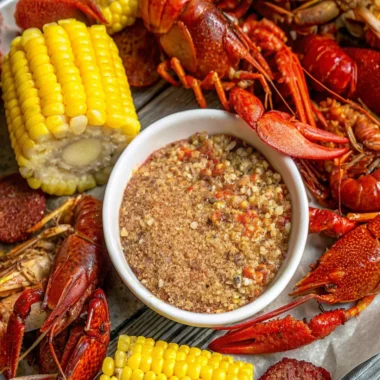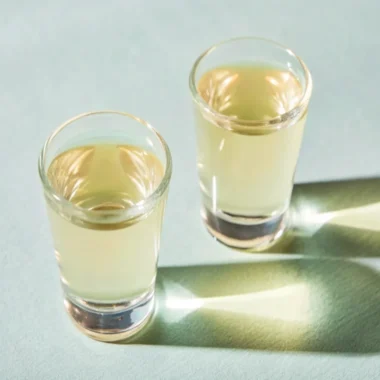Have you ever wondered what makes a seafood boil recipe truly unforgettable? It’s not just the quality of the seafood that counts, but the sauce you serve it with. Imagine indulging in succulent shrimp, tender crab legs, and juicy lobster tail—all coated in a rich, flavorful seafood boil sauce that elevates the entire meal. But what if we told you that creating this perfect sauce can be both simple and quick?
In this blog post, we’ll explore how to make a seafood boil sauce recipe that’s not only easy but also packed with layers of flavor. With just a few ingredients, you can create a sauce that enhances your seafood without overwhelming it, making it a memorable experience for anyone at your dinner table. Whether you’re a seasoned chef or a beginner in the kitchen, this seafood recipe will be your go-to for a flawless seafood boil.
Ingredients List: The Essentials for Your Seafood Boil Sauce
A successful seafood boil sauce is all about balancing bold flavors without overpowering the delicate taste of the seafood. Below is the list of ingredients you’ll need to create the ultimate sauce, along with some suggestions for substitutions.
Key Ingredients:
- Butter (1 cup): The foundation of any good seafood boil sauce. It creates a rich, velvety texture that helps the flavors come together.
- Garlic (6 cloves, minced): Fresh garlic gives the sauce its aromatic punch. You can substitute with garlic powder if needed.
- Lemon Juice (1/4 cup): This adds a zesty freshness that cuts through the richness of the butter and seafood. Freshly squeezed lemon is preferred.
- Old Bay Seasoning (2 tablespoons): The perfect blend of spices for a classic seafood boil flavor. If you don’t have Old Bay, you can use a mixture of paprika, cayenne pepper, and celery salt.
- Paprika (1 tablespoon): Adds color and a slight smokiness.
- Cayenne Pepper (1/2 teaspoon): For a little heat. Adjust according to your spice tolerance.
- Parsley (2 tablespoons, chopped): Fresh parsley brings a burst of color and a fresh finish to the sauce.
- Chicken Broth (1/4 cup): A small amount to help create a smoother consistency.
- Salt and Pepper (to taste): To season and balance the flavors.
- Crushed Red Pepper Flakes (optional, 1/4 teaspoon): If you prefer a more intense heat, this is a great addition.
Optional Substitutions:
- Lemon Zest: If you want a more intense citrus flavor, lemon zest can be used in addition to or in place of the lemon juice.
- Vegetable Broth: For a slightly lighter sauce, vegetable broth can replace chicken broth, making it ideal for vegetarians or seafood-lovers avoiding animal products.
- White Wine: If you’re looking to elevate the flavor profile, adding a splash of white wine creates a deeper, more complex sauce.
Timing: Quick and Easy Preparation
Creating a seafood boil sauce shouldn’t take hours. Here’s a breakdown of the timing to ensure everything is ready for your seafood feast:
- Preparation Time: 5 minutes
- Cooking Time: 10 minutes
- Total Time: 15 minutes
This sauce is ready in a fraction of the time compared to many other complex seafood recipes, making it an ideal choice for busy evenings when you want to impress your guests without spending hours in the kitchen.
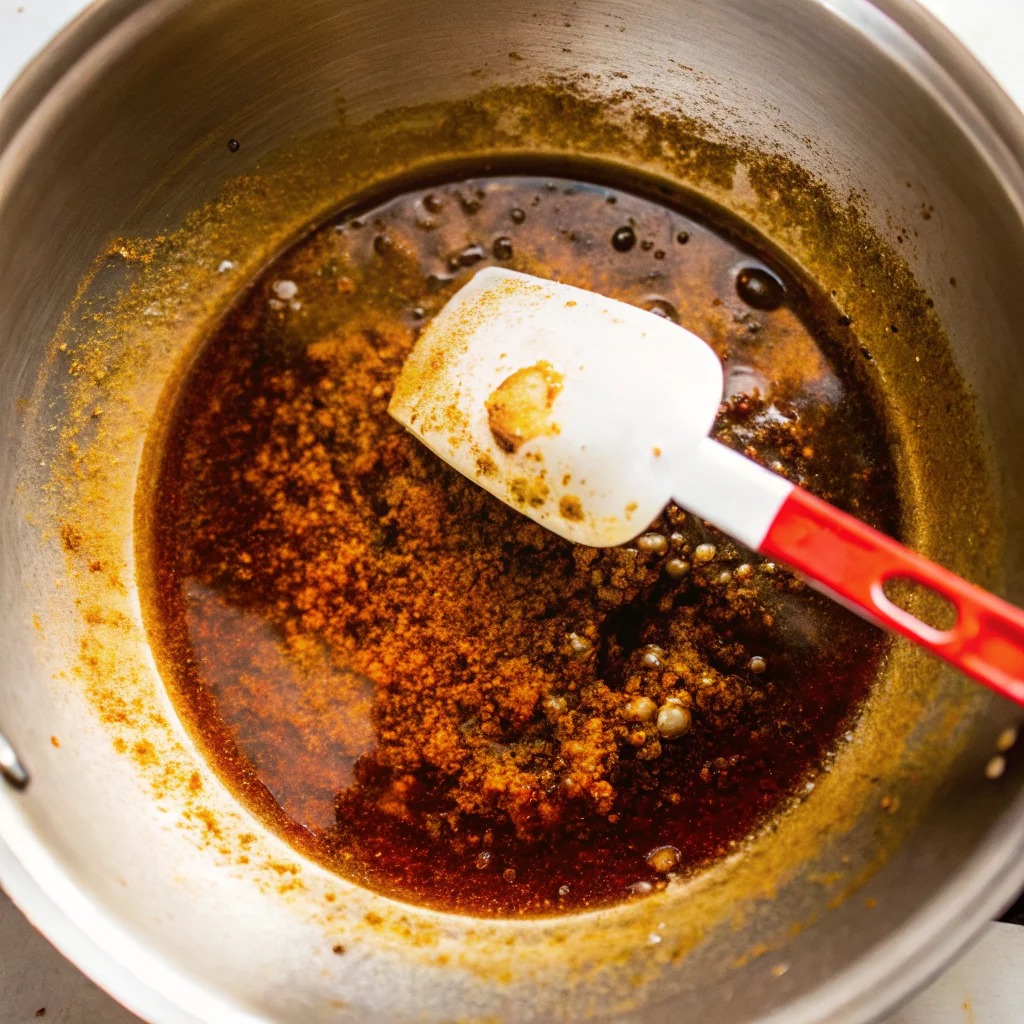
Step-by-Step Instructions: How to Make the Perfect Seafood Boil Sauce
Making a flavorful seafood boil sauce is incredibly easy when you follow these simple steps. The key is to blend the ingredients gradually to build the perfect sauce without overwhelming the seafood.
Step 1: Melt the Butter
In a large pan, melt 1 cup of butter over medium heat. Stir occasionally to ensure the butter doesn’t brown. You want it to melt slowly to create a smooth base for the sauce.
Pro Tip: Don’t rush this process! Melting the butter slowly allows it to integrate better with the spices and liquids later on.
Step 2: Sauté the Garlic
Once the butter is fully melted, add in the minced garlic and sauté for 2 minutes. You want the garlic to become fragrant but not browned, as burnt garlic can create a bitter taste in your sauce.
Pro Tip: Adjust the garlic according to your taste. If you love garlic, feel free to add a little more for an extra punch!
Step 3: Add the Lemon Juice and Seasonings
Next, stir in 1/4 cup of freshly squeezed lemon juice and the Old Bay seasoning. The lemon juice will brighten up the rich butter, while the Old Bay adds the classic seafood flavor. Add the paprika, cayenne pepper, salt, and pepper, and mix well.
Pro Tip: For a more intense citrusy kick, add lemon zest at this stage for an extra burst of flavor.
Step 4: Pour in the Chicken Broth
Add 1/4 cup of chicken broth into the pan, stirring continuously. This will help create a smoother sauce and ensure it evenly coats your seafood.
Pro Tip: If you’re looking for a bit of depth, try substituting the chicken broth with a dry white wine. It adds complexity to the sauce without overpowering the seafood.
Step 5: Simmer and Adjust
Let the sauce simmer for 3–4 minutes. Taste it and adjust the seasoning as needed. If the sauce feels too thick, add a little more chicken broth or water until you achieve the consistency you like.
Pro Tip: For extra richness, you can stir in a tablespoon of cream or sour cream.
Step 6: Garnish and Serve
Once your sauce is simmered and perfectly seasoned, remove it from the heat. Stir in the chopped parsley for a fresh, herby finish.
Pro Tip: Serve immediately by drizzling the sauce over boiled or grilled seafood, or toss the seafood directly into the sauce for full flavor immersion.
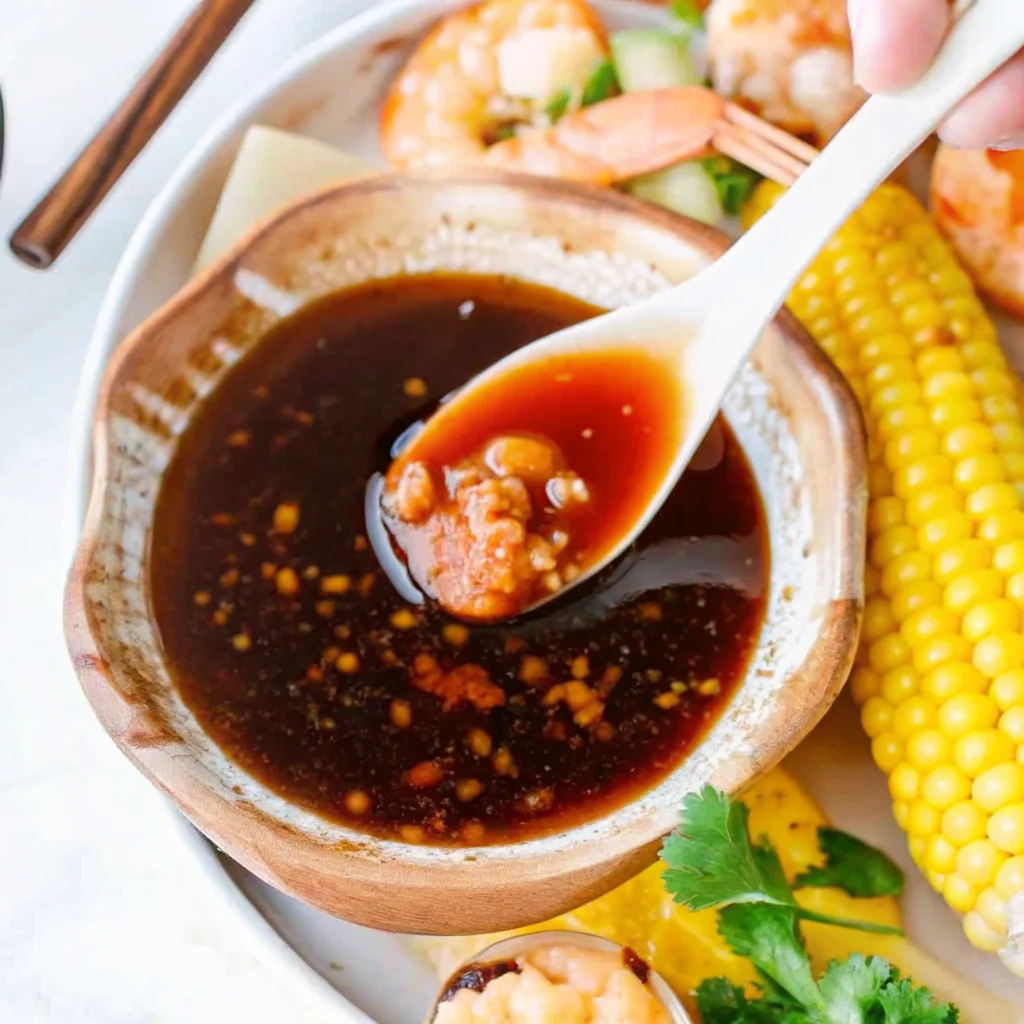
Nutritional Information: A Breakdown of the Flavorful Sauce
If you’re conscious about your health and nutritional intake, it’s important to know the details of the sauce you’re preparing. Here’s a quick look at the nutritional profile per serving (based on approximately 1/4 cup of sauce per serving):
- Calories: 120
- Total Fat: 13g
- Saturated Fat: 8g
- Cholesterol: 30mg
- Sodium: 240mg
- Total Carbohydrates: 3g
- Dietary Fiber: 1g
- Sugars: 1g
- Protein: 1g
Note: These values may vary depending on ingredient substitutions, such as using less butter or swapping chicken broth for a lighter option.
Healthier Alternatives for the Recipe
While the seafood boil sauce is rich and indulgent, there are several ways to make it a little lighter without sacrificing flavor.
- Substitute Butter for Olive Oil: Olive oil is a heart-healthy alternative that can replace butter. It will create a slightly lighter, yet still flavorful, sauce.
- Use Low-Sodium Broth: To reduce the salt content, opt for a low-sodium chicken or vegetable broth.
- Skip the Cream: If you prefer a lighter sauce, you can omit the cream or sour cream and rely on the richness of the butter and garlic.
Serving Suggestions: How to Enjoy Your Seafood Boil Sauce
A well-made seafood boil sauce can be paired with a variety of dishes to elevate your meal. Here are a few serving ideas:
- Classic Seafood Boil: Toss your shrimp, crab, lobster, and potatoes into the sauce for a classic seafood boil. Serve it with corn on the cob for a full experience.
- Grilled Seafood: Drizzle the sauce over grilled shrimp, crab legs, or even fish fillets.
- Seafood Pasta: Use the sauce as a flavorful base for a seafood pasta dish. Toss it with linguine, fettuccine, or spaghetti for a quick and satisfying meal.
- Dipping Sauce: Serve the sauce on the side as a dipping sauce for crab claws, shrimp, or even fried seafood.
Common Mistakes to Avoid
While making a seafood boil sauce is easy, here are a few common mistakes to watch out for:
- Burning the Garlic: Garlic can burn quickly, which leads to a bitter flavor. Always sauté it on medium heat and remove it from the pan once it becomes fragrant.
- Over-seasoning: Adding too much salt or spice can overpower the delicate flavors of your seafood. Always taste the sauce as you go and adjust gradually.
- Not Adjusting Consistency: If your sauce is too thick, it can be hard to coat the seafood. Thin it out with a little broth or water to maintain the right consistency.
Storing Tips for the Recipe
If you have leftovers (or if you want to prep ahead), here are some helpful storing tips:
- Storing Leftovers: Place any leftover sauce in an airtight container and refrigerate for up to 3 days. Reheat gently on the stove to bring back its original flavor.
- Freezing: You can freeze the sauce for up to 2 months. When reheating, allow it to thaw in the refrigerator overnight, then heat on low to prevent separating.
- Make-Ahead: You can prepare the sauce a day ahead, store it in the fridge, and reheat it when you’re ready to serve.
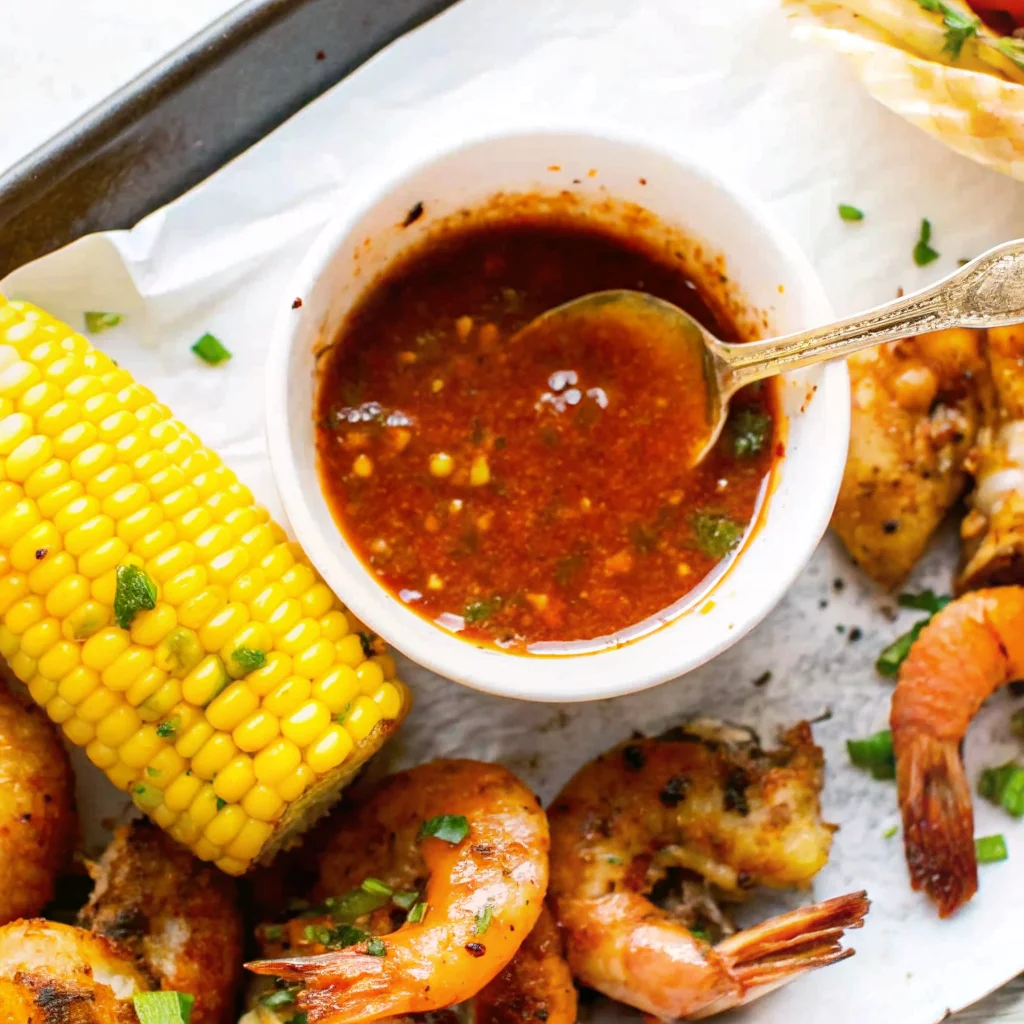
Conclusion
Creating a delicious seafood boil sauce recipe that is both simple and flavorful is within your reach! By following these easy steps, you can enjoy a seafood feast that’s elevated by a zesty, buttery sauce without spending hours in the kitchen. Whether you’re making it for a family dinner or hosting a large party, this sauce is guaranteed to impress.
Call to Action
We invite you to try this seafood boil sauce recipe and share your experience with us. Leave a comment below or share your thoughts in the review section. Don’t forget to subscribe for more easy and tasty seafood recipes like this one!
FAQs
What is a seafood boil sauce made of?
A seafood boil sauce is made of butter, garlic, lemon juice, Old Bay seasoning, paprika, cayenne pepper, and chicken broth. These ingredients come together to create a flavorful and tangy sauce that enhances the taste of seafood.
Can I use a different seasoning besides Old Bay?
Yes! If you don’t have Old Bay seasoning, you can substitute it with a mixture of paprika, cayenne pepper, and celery salt. This will still give your sauce the classic seafood boil flavor.
How long will leftover seafood boil sauce last?
Leftover seafood boil sauce can be stored in the fridge for up to 3 days. If you’d like to store it longer, you can freeze it for up to 2 months.
Can I make the sauce ahead of time?
Absolutely! The sauce can be made ahead of time and stored in the fridge. Simply reheat it before serving for the best taste.
Print
Seafood Boil Sauce Recipe Easy
- Total Time: 15 minutes
- Yield: 4–6 servings 1x
Description
This seafood boil sauce is the perfect addition to any seafood feast. A flavorful blend of butter, garlic, Old Bay seasoning, and lemon juice creates a tangy, buttery sauce that complements shrimp, crab, lobster, and other seafood. It’s quick to prepare and will elevate your seafood boil to a whole new level.
Ingredients
-
1 cup butter (unsalted preferred)
-
6 cloves garlic, minced
-
1/4 cup fresh lemon juice
-
2 tablespoons Old Bay seasoning
-
1 tablespoon paprika
-
1/2 teaspoon cayenne pepper
-
Salt and pepper to taste
-
1/4 cup chicken broth (or vegetable broth)
-
2 tablespoons chopped fresh parsley
-
(Optional) 1/4 teaspoon crushed red pepper flakes for extra heat
Instructions
-
Melt the Butter:
In a large pan, melt 1 cup of butter over medium heat. Stir occasionally to ensure the butter does not brown. -
Sauté the Garlic:
Add 6 minced garlic cloves to the pan and sauté for about 2 minutes or until fragrant. Be careful not to brown the garlic. -
Add Lemon Juice and Seasonings:
Stir in 1/4 cup of fresh lemon juice, 2 tablespoons of Old Bay seasoning, 1 tablespoon of paprika, and 1/2 teaspoon of cayenne pepper. Season with salt and pepper to taste. Stir until everything is well combined. -
Add Chicken Broth:
Pour in 1/4 cup of chicken broth and mix. Let the sauce simmer for 3-4 minutes to allow the flavors to blend. -
Finish and Garnish:
Once the sauce is heated through and well-seasoned, remove from the heat. Stir in 2 tablespoons of chopped fresh parsley.
-
Serve:
Pour the sauce over your seafood, or toss the seafood directly in the sauce for a full flavor experience.
Notes
-
Substitutions: If you don’t have Old Bay seasoning, you can make your own with a mix of paprika, celery salt, and cayenne pepper. You can also use vegetable broth instead of chicken broth for a vegetarian-friendly option.
-
Make Ahead: This sauce can be made in advance and stored in the refrigerator for up to 3 days. Reheat gently on low heat before serving.
-
Adjust the Spice: If you prefer a spicier sauce, you can increase the amount of cayenne pepper or add crushed red pepper flakes.
- Prep Time: 5 minutes
- Cook Time: 10 minutes
- Category: Seafood, Sauce
- Method: Stovetop
- Cuisine: American
Keywords: seafood recipe, seafood boil sauce, easy seafood sauce, seafood boil recipe

